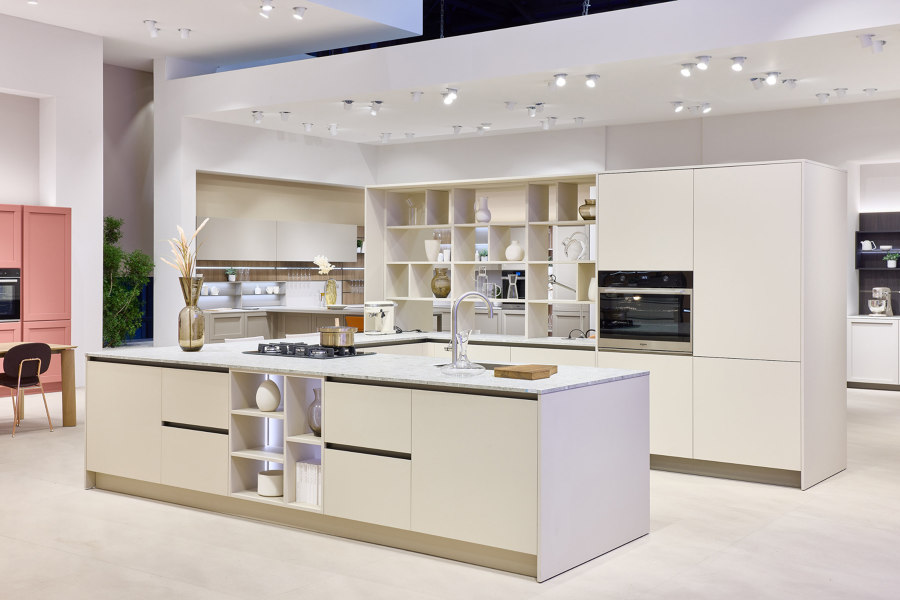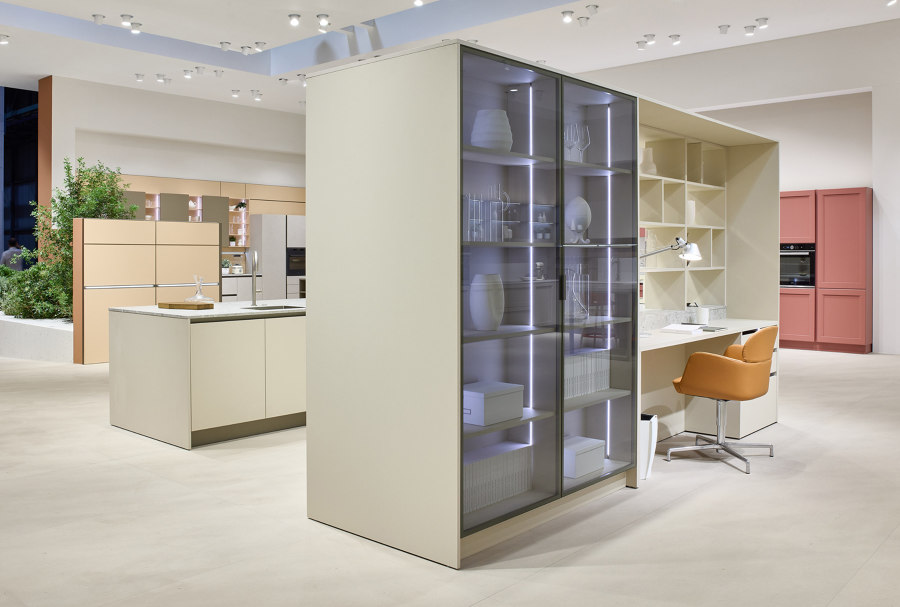Veneta Cucine: kitchen evolutions and modern solutions
Storia del Marchio di Emma Moore
Biancade (TV), Italia
15.09.22
Italian brand Veneta Cucine has been helping to shape our kitchens for 55 years, and today continues to respond to the challenges of designing for post-pandemic domestic spaces.
Kitchens aren’t just for cooking. Veneta Cucine’s exhibition at Eurocucine 2022 demonstrated how they can accommodate all life, from work to hobbies to laundry and clothes management
On the first day of the first lockdown in 2020, a hand-crafted ‘school’ sign went up on our front door, an equally home-spun new school badge was pinned to the child’s chest, and a bell was installed on the kitchen table to signal the start of lessons. Yes, the kitchen table. Because somehow we knew that we would be segueing between toast and jam and fractions, explorations in bread-making and phonetics, cups of hot chocolate, and scientific experiments. Fitness regimes, meanwhile, plotted a course around the kitchen table and onwards one way into the garden and the other into the living room. Kitchens have, for quite some time, been evolving into the social hub of the home; the pandemic taught us that they could be much more even than that.
‘During and after the Covid period, people have been approaching the interior design of their own houses in a totally different way,’ says Architect Damiano Zambon, who works with Italian kitchen manufacturers Veneta Cucine. ‘Kitchen design has evolved towards smart working, but also in the direction of a space for pleasure, where you live your passions and your personal hobbies.’
Streamlined cabinets and countertops in considered materials show minimal interruption from handles and appliances, bringing kitchen design in line with the rest of the house

Streamlined cabinets and countertops in considered materials show minimal interruption from handles and appliances, bringing kitchen design in line with the rest of the house
×Changing functionality
It’s a lifestyle change we now see reflected widely in the latest kitchen design, affecting the way space is allocated within a layout – towards expected kitchen functions and towards less expected ones, and the segregation of the messy, or ‘wet’ food prep areas, and the more social/living/working ‘dry’ parts. But also in the types of storage worked into the design, and the materials and detailing. After all, if the kitchen is to further integrate into the home and fulfil all of life’s demands, it needs to blend stylistically with the other internal spaces.
‘During and after the Covid period, people have been approaching the interior design of their own houses in a totally different way’
Veneta Cucine, which has been integral to the last 55 years of kitchen evolutions, has been assessing the kitchen’s latest functional changes and responding with a thoroughly rounded fresh approach. Its Start Time kitchen has integrated a dedicated home working station while ways have been found to accommodate other activities and their accoutrements. ‘For example, the space for wine and wine accessories in a walk-in column, that is not only a wine cellar, but a sort of secret corner housing all the special tools and accessories that a passionate wine lover could desire,’ says Zambon.
Another development is multifunctional storage space, including those where clothes, shoes and accessories can be steamed, deodorised and sanitised by UV LED and stored, when combined with Samsung’s Airdresser system. ‘The kitchen is not only central to the cooking, dining, and living functions of the house, it is central to the whole house. Every user can decide which functions are key to the home, and the kitchen becomes the infrastructure that makes it possible.’
Veneta Cucine’s Start Time kitchen integrates a work zone – a dedicated desk space built between the cabinetry, where you can fire up the laptop and truly make the kitchen the hub of the home

Veneta Cucine’s Start Time kitchen integrates a work zone – a dedicated desk space built between the cabinetry, where you can fire up the laptop and truly make the kitchen the hub of the home
×Material integration
The fluid boundaries that result require more synchronicity of material and form to plug the kitchen in seamlessly to the rest of the house – alongside choice; the ability to customise the assembly of kitchen features and materials. Interior architecture is leaning more and more towards what Zambon calls ‘real and clear’ materials – and accordingly real wood, glass, quartz and ceramic alongside the colours and textures of nature are available to kitchens too. Veneta Cucine’s new Caranto worktops come in ceramic or quartz, and are highly resilient to all manner of onslaughts, while presenting a beautiful mineral finish.
‘The kitchen is not only central to the cooking, dining, and living functions of the house, it is central to the whole house’
‘The general trend is a return to nature and earthy colours,’ says Zambon. ‘Light green, light sand, light and warm ground colours are the trends, together with dark natural burnished woods or with light natural woods.’ Surfaces have also gained texture – Veneta Cucine has developed a textured finish called Canneté that is applied to wood veneer, glass and lacquered surfaces.
Good form
As for form – kitchen cabinets are all but losing their plinths, handles become less visible and tall columns have become walk-in while glass fronts blur the boundaries further. The ceramic Caranto worktop conceals an induction hob beneath it, leaving a clean and uncluttered hybrid surface when cooking is not on the agenda.
All these life-enhancing changes to kitchen design were no doubt coming down the line when we were dinging the bell for home-school kick-off back in early 2020. But two years of shoe-horning new functionality into our food-prep areas has cemented the need for such change, and seemingly, turbo-charged its advent.
© Architonic



